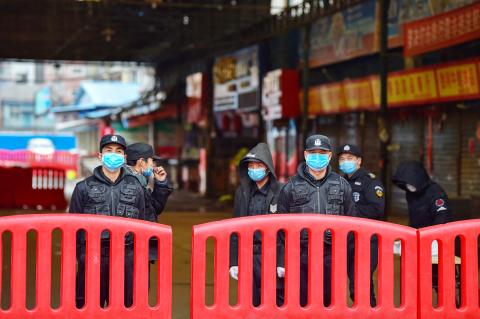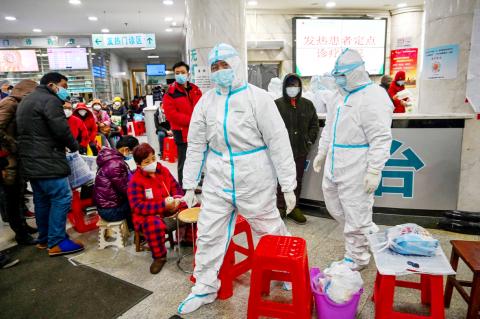For eight days, an AFP team lived and worked at the centre of a global health emergency, witnessing how life in the Chinese city of Wuhan was turned upside down as it was cut off from the world.
The city of 11 million was placed under an unprecedented quarantine to try and stop the spread of a deadly new coronavirus.
The virus, which has since gone on to kill more than 1,000 people across China, is believed to have crossed into humans from an animal market in Wuhan.

Photo: AFP
We arrived in Wuhan the day the city was place under lockdown, and over the next week captured remarkable images of shock and resignation, despair and bravery.
AFP re-publishes some of the team’s most compelling images, along with this new account of the harrowing events.
DAY ONE: THE LOCKDOWN

Photo: AFP
In the early hours of Jan. 23, China announces that all air, road and train links out of Wuhan will be suspended.
The virus has killed 17 people and infected more than 500, authorities say, just as millions of people are criss-crossing the country to reunite with friends and family for the Lunar New Year holiday.
The news comes as a shock, and most don’t even try to flee Wuhan before the order comes into force at 10am. But the few locals out on the streets do seem to be obeying the new rules that masks must be worn in public.
The railway station prepares to close later that day, with police chasing the last travelers out of the building. The usually bustling airport is deserted. Even the officials tasked a few hours ago with testing passengers for signs of fever have gone.
A handful of travelers are stuck, and an airport employee says she does not know when her shift will finish in the confusion.
The expressway into town is empty, as are the rest of the roads in the metropolis. Wuhan has just been cut off from the world and its people, terrified of being infected, are confining themselves to their homes.
DAY 2: NEW YEAR’S EVE
Hours before the Lunar New Year, shops are closed and there is a ghostly silence hanging over the city. The police and security services — usually so prominent on Chinese city streets — are conspicuous by their absence.
The Qiaokou district and its famous Jinghan avenue look like they had been abandoned. All of the boutique shops inside an imposing business complex are shuttered by metal gates.
In a small apartment in a 20-storey building in the south of the city, Wang Yanhong, 53, welcomes a team of foreign journalists for the eve of the Lunar New Year.
Her husband Pen Lixin prepares a variety of dishes and a bottle of local red wine sits on the table. But the atmosphere is not one of celebration: the quarantining of Wuhan has meant that their son Andy, 25, was unable to make it home.
“This is the first time he hasn’t come home to celebrate New Year with us,” says Wang sadly.
DAY 3: NEW YEAR’S DAY ... AT THE PHARMACY
The Guiyan temple, normally packed with hundreds of thousands of people welcoming in the New Year, is closed.
“No-one is allowed inside in order to prevent the virus spreading,” a uniformed man — who is not wearing the compulsory mask — says.
About town, the usual New Year visits are limited to a worried dash to the pharmacy, where customers are greeted by staff wearing full-body protective suits and double masks.
Anti-fever tablets are limited to two boxes per person.
The radio broadcasts on this first day of the Year of the Rat are hardly any more festive.
Messages on virus prevention and calls for the wearing of masks listeners to wear masks, and a song set to a rap beat tells Wuhan’s people that they are “strong enough to defeat the virus.”
DAY 4: HOSPITALS OVERWHELMED
In the hospitals, people line up in long lines to see a doctor.
The wait is so long that some have brought their own chairs.
One feverish man in his 30s prepares to line up all night in order to see a doctor the next day.
“I’ve been going from hospital to hospital to hospital for two days,” he says. “I haven’t slept.”
People approach foreign journalists unprompted — a rare sight in China — to describe grim scenes in other hospitals.
“Like a horror film,” says one witness, who says bodies were left unattended for hours.
About 20km from the city center, where police man roadblocks, nurses are allowed into the city to help exhausted colleagues in the hospitals.
DAY 5: ‘LET’S GO WUHAN!’
All non-essential traffic has been banned since midnight. Taxis have been requisitioned.
On the outskirts, hundreds of workers who arrive just days earlier are building two new hospitals from scratch.
Across a vast stretch of muddy ground, cranes and excavators dance a ballet, as they race to finish a 1,000-bed medical facility within days.
“We’ve got to go fast so we can beat the virus,” says one man, who has been working nine hours a day and sleeps near the construction site.
People have been instructed to say in their homes, but some ignore the risk of infection and venture out to help.
A man named Zhang Lin and other volunteers ferry sick people to and from hospital in their cars.
“We need to take the initiative and help out,” he says as he waits outside a clinic to take a patient home.
That evening on the edge of the Yangtze River, four Chinese characters are lit up in pink: “Let’s go Wuhan.”
The slogan will become a rallying cry for the city.
DAY 6: STAY OR GO?
As the city passes five days under lockdown, foreign countries begin planning to evacuate their citizens in Wuhan.
But that doesn’t appeal to Remy, a Frenchman who has been living in Wuhan for eight years.
“For the moment, it’s fine here,” says the 33-year old, wearing a blue face mask.
He’s not been leaving his apartment though, just like students from the Dominican Republic, who were waiting desperately for news from their embassy.
Another Frenchman, Philippe Klein is also staying put.
“It’s not an act of heroism,” he says. “It’s been well thought out, it’s my job,” he says of his decision.
DAY 7: THE GHOST HOTEL
Compulsory masks, temperature checks and no restaurant: welcome to the Marco Polo Hotel, one of the few in Wuhan that has not closed it doors. You know something is wrong as soon as you enter. There’s no one at reception, and there is a heavy silence, which jars with the festive decorations all around.
The terrified staff serve the few customers their meals in their rooms.
A guard takes the temperature of customers every time they go out or come back.
“Below 37.3 Celsius it’s fine; above, and we take the necessary measures,” says a thermometer-wielding Xiao Fan.
DAY 8: DEATH ON AN DESERTED STREET
The body of a man in his 60s lies stiff on his back in front of a closed furniture store, near a hospital. He’s still wearing a facemask.
Officials in hazard suits take every precaution as they approach the body.
A team of forensic experts who examined him are immediately sprayed with disinfectant by colleagues after removing their hazardous material suits.
The body is placed in a yellow surgical bag and taken away in a van as distraught residents looks on. The area is disinfected.
“It’s terrible,” says one. “So many people have died in recent days.”

On April 26, The Lancet published a letter from two doctors at Taichung-based China Medical University Hospital (CMUH) warning that “Taiwan’s Health Care System is on the Brink of Collapse.” The authors said that “Years of policy inaction and mismanagement of resources have led to the National Health Insurance system operating under unsustainable conditions.” The pushback was immediate. Errors in the paper were quickly identified and publicized, to discredit the authors (the hospital apologized). CNA reported that CMUH said the letter described Taiwan in 2021 as having 62 nurses per 10,000 people, when the correct number was 78 nurses per 10,000

As we live longer, our risk of cognitive impairment is increasing. How can we delay the onset of symptoms? Do we have to give up every indulgence or can small changes make a difference? We asked neurologists for tips on how to keep our brains healthy for life. TAKE CARE OF YOUR HEALTH “All of the sensible things that apply to bodily health apply to brain health,” says Suzanne O’Sullivan, a consultant in neurology at the National Hospital for Neurology and Neurosurgery in London, and the author of The Age of Diagnosis. “When you’re 20, you can get away with absolute

When the South Vietnamese capital of Saigon fell to the North Vietnamese forces 50 years ago this week, it prompted a mass exodus of some 2 million people — hundreds of thousands fleeing perilously on small boats across open water to escape the communist regime. Many ultimately settled in Southern California’s Orange County in an area now known as “Little Saigon,” not far from Marine Corps Base Camp Pendleton, where the first refugees were airlifted upon reaching the US. The diaspora now also has significant populations in Virginia, Texas and Washington state, as well as in countries including France and Australia.

May 5 to May 11 What started out as friction between Taiwanese students at Taichung First High School and a Japanese head cook escalated dramatically over the first two weeks of May 1927. It began on April 30 when the cook’s wife knew that lotus starch used in that night’s dinner had rat feces in it, but failed to inform staff until the meal was already prepared. The students believed that her silence was intentional, and filed a complaint. The school’s Japanese administrators sided with the cook’s family, dismissing the students as troublemakers and clamping down on their freedoms — with